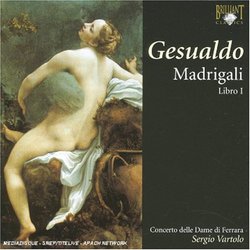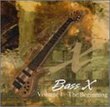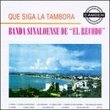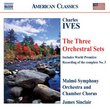| All Artists: Carlo Gesualdo, Concerto delle Dame di Ferrara Title: Gesualdo: Madrigali, Libro I Members Wishing: 0 Total Copies: 0 Genres: Pop, Classical Styles: Vocal Pop, Opera & Classical Vocal Number of Discs: 1 SwapaCD Credits: 1 UPCs: 5028421926353, 842977026351, 675754851828 |
Search - Carlo Gesualdo, Concerto delle Dame di Ferrara :: Gesualdo: Madrigali, Libro I
 | Carlo Gesualdo, Concerto delle Dame di Ferrara Gesualdo: Madrigali, Libro I Genres: Pop, Classical
|
Larger Image |
CD DetailsSimilar CDs |
CD ReviewsVigorous, Expressive Singing Giordano Bruno | Wherever I am, I am. | 11/06/2008 (5 out of 5 stars) "Carlo Gesualdo (1566-1613) commissioned the murder of his first wife and her lover in 1590. By 1594, he was the Prince of Venosa, having inherited the estate from his father, and engaged in a major political marriage to Eleanora d'Este of Ferrara. For the Ferrarese court, the marriage was intended as a bulwark against the absorption of Ferrara into the Papal States. For Gesualdo, it was above all a chance to visit Ferrara, the leading center of madrigal composition, and to meet his idol, the composer Luzzascho Luzzaschi. Gesualdo walked a fine line as an aristocrat more interested in music than in the proprieties of his status. Even the publication of his first book of madrigals was something of a violation of class consciousness in his milieu.
Gesualdo went on to publish three more books of madrigals, ever more innovative, in about 15 months. In 1596, he suddenly left Ferrara, never to return. In 1597, Eleanora joined him in Venosa with their infant son, who died in 1600. It seems that Gesualdo had collapsed into a profound depression and a religious crisis, one that had a silver lining for later centuries of music lovers in the form of Gesualdo's madrigalesque "Cantiones sacrae" and other works of profound penitential beauty, published in 1603. Gesualdo's psychological illness almost certainly contributed to his early death, at age 47. Before he died, however, he published again; in 1611, his Responsori per la Settimana Santa appeared, together with his fifth and sixth books of madrigals. Musicologist now believe that those 'later' madrigals had in fact been written in Ferrara, before the religious crisis, and that Gesualdo had merely preserved them, despite their secular nature, because he hadn't the heart to destroy them. Already in this First Book of Madrigals, Gesualdo was as masterful at affective, emotive writing as any of his mentors, including Luzzaschi. And Gesualdo had a natural gift for melody, something that Italians like conductor Sergio Vartolo insist is inherently "southern" and Neapolitan. As Vartolo points out, the acceptance of highly-skilled female singers at the court of Ferrara and in Naples was also important in the development of Gesualdo's flamboyant art. Vartolo maintains that male "falsettists" were not at all in vogue at that specific moment of musical history. Vartolo's ensemble - Concerto delle Dame di Ferrara, the Concert of Women of Ferrara - is not all female on this CD! It includes two women sopranos, a woman alto, two male tenors, and a male basso, plus harp and harpsichord. As usual with recordings by Vartolo and his ensembles, there are some rough spots and some lapses of togetherness, but the energy of interpretation and the vibrancy of the individual voices far outweigh such minor flaws. This is, by the way, a recording of a live concert performance at the "Gesualdo Today Festival" of 2004, in the very southern Italian province of Basilicata, with funding from the provincial government." |

 Track Listings (20) - Disc #1
Track Listings (20) - Disc #1


